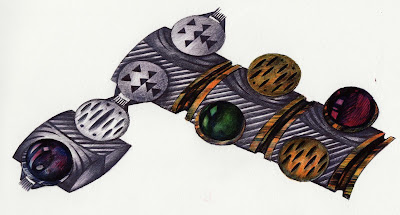 |
| Neck piece Jewellex 2000. Form and Function in Africa. Finalist Professional Designer category. |
This blog entry focuses on the design of my first Jewellery piece, from concept, right through the design development phase, including visual documentation of the final neck piece. The design was entered into the Jewellex competition in 2000, organized by the Jewellery council of South Africa. I was judged a finalist (one of 12); based on my entry of presentation drawings.
With the recent closure of the Ceramic Design Programme at the University of Johannesburg, I have taken up an academic lecturing position in the Jewellery Department, where I am responsible for the induction program; teaching drawing and design (2-dimensional & 3-dimensional studies) to the first years, as well as design to second and third years. This blog entry showcases the concept, design and development, including the presentation drawings of the piece.
 |
| Designing the neck piece. |
I spent a long time refining the concept as well as the design and development of the actual piece. As the competition entries were judged on your submission of presentation drawings, it makes for a detailed and systematic record of the entire design process. What is recorded here is therefore an explication of the neck piece, the reference material, including the design idea and the concept.
 |
| Neck piece seen from above. |
The explication is divided into three stages and or phases. Stage one is the conceptual development phase (reference material and ideas), then follows stage two - the design and development phase (to determine forms and shapes and more importantly the construction techniques and methods) and finally stage three - the presentation drawings (the final ballpoint pen drawings submitted to meet the requirements for the competition. I have always admired African artifacts, especially the styling and fine craftsmanship of the artists that constructed the pieces. I therefore made a series of drawings of various artifacts that could inform the form and shape of the individual motifs, the individual pieces that make up the neck piece - see reference material below.
 |
| Conceptual drawings |
The work was selected from a few thousand entries, one of 12, to be manufactured for the final adjudication of the winner. As the prejudging was selected on the strength of the design as visualized in the presentation drawings and not the final jewellery pieces, you're drawing skills were of paramount importance. Computer software programs such as CAD and Rhino has changed all of this dramatically. Drawing however remains a tool to facilitate the development of the idea, to visualize the concept and design development of an idea into reality. I hope and trust that the entry will be of assistance to those who are in searching of a design and development methodology to realize their ideas on paper.
 |
| Design development drawings |
Conceptual Development.
Coming up with a concept is the first stage of any design idea. I new I wanted to make a neck piece and that my inspiration had to be firmly rooted in our very own indigenous culture. Indigenous knowledge had to add to the meaning and significance of the pieces.
 |
| Neck piece side view. |
Reference Material.
A Zulu meat platter and Zulu earplugs formed the inspiration and reference material for the development of the concept. The meat platter’s form and shape gave rise to the individual components that are literally chained together to form the neck piece. The earplugs were referenced as decorative possibilities; the patterns inserted into the bowls of the meat platters (see image below).
Zulu Meat Platter. 'Meat platters of various sizes, some of them big enough to hold large quantities of meat for communal distribution and consumption on special occasions, are still used throughout the area of present day KwaZulu-Natal. Reserved for the roasted meat of ritually slaughtered goats or oxen, their widespread use underlines the continuing importance rural Zulu-speakers ascribe to their ancestors in securing the well-being of the living' (Philips T, 1999:224).
 |
Meat Platter (ugqoko), Zulu. KwaZulu-Natal, South Africa. Wood. 80cm length. Private Collection. |
Earplugs
'In my search for appropriate decoration and or surface development options, earplugs featured here made the most significant impact. Development of earplugs is related to the custom of ear piercing, still widely practiced on south-east Africa, especially among Zulu-speaking people. Historically, it was an important ceremony performed on every Zulu child before puberty. It incorporated some of the features of the circumcision and initiation ceremonies which are still practiced by many southern Nguni but which fell into disuse among the Zulu during the early 19th century' (
Pairs of earplugs (left). Zulu. South Africa. 20the century.6cm. Jonathan Lowen Collection. (cited in Africa the Art of a continent: 219)
 |
| Design development drawings |
 |
| Presentation drawing of joined components. |
Design development phase.
Then follows the design development phase. This is the refining of the design idea considering the manufacturing options. This also includes the final styling as well as the presentation drawings seen below. The drawings has to convince the judges and provide the manufacturer of the piece with the necessary detail to be able to realize the idea in terms of jewellery techniques and methods. The final piece should resemble the piece in the drawing as close as possible – do justice to the design in every way possible. However there are times when adjustments are made during the manufacturing phase to take the piece to a new level. However these changes should always be communicated to the designer to ensure the final piece is a reflection of the concept and in keeping with his intent.
 |
| Presentation drawing of neck piece, seen from above. |





